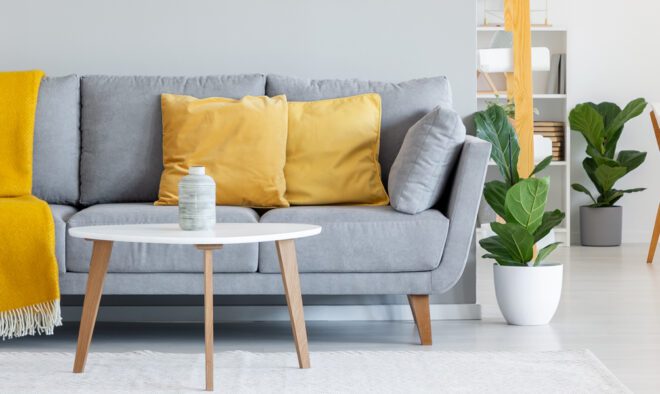The Reshaping of Home Furnishings Demand and Purchase Behavior

Matt Perry, Senior Valuation Director at Hilco Valuation Services, speaks about how the pandemic has shaped demand and consumer purchase behavior in the home furnishings market and how expected developments across the supply chain are likely to impact the industry for the final two quarters of 2021.
Steve Katz:
Hello again, and welcome to the Hilco Global Smarter Perspective Podcast Series. I’m your host, Steve Katz. Today, we’re speaking with Matt Perry, Senior Valuation Director at Hilco Valuation Services about how the pandemic has shaped demand and consumer purchase behavior in the home furnishings market, and how expected developments across the supply chain are likely to impact the industry for the final two quarters of 2021.
Steve Katz:
Just as a little quick background, ABLs and manufacturers alike have achieved a high level of success in partnership with Hilco Valuation Services based upon its disciplined process, industry-leading bench strength, systematic and collaborative approach. Throughout the pandemic, Hilco has amassed critical insights and data that are enabling delivery of highly accurate valuations across the home furnishings industry and the associated supply chain as we move ahead during this continuing highly volatile period. With that said, welcome to the podcast, Matt.
Matt Perry:
Hi Steve. Glad to be here today.
Steve Katz:
Well, we’re glad to have you on to share your thoughts on what’s going on in home furnishings, especially given how much has changed for consumers in terms of both their work and their home lives over the past year and a half or so. So, my first question kind of focuses on the fact that for over a year, the realities of the pandemic have dictated the need for people across the globe to spend precedented amount of time living, working, and recreating from their own homes. Finally, we were beginning to witness a return to some semblance of normalcy, but with the recent emergence of the Delta variant here in the US and elsewhere, we may not be out of the woods yet. So my question is what impact has this lifestyle shift had on the home furnishings market from your viewpoint?
Matt Perry:
As you mentioned, over the past year and a half with the government-ordered restrictions and lockdowns, it’s definitely changed our way of living. The pandemic has limited our ability to spend time with friends and family, to go out and entertain and travel. Effectively, our homes have become our workplaces, our school rooms, our family gathering spots, and with little money being spent on travel and entertainment, people have really reallocated to discretionary income to home improvement projects, focus on repairs and renovations, as well as updated design and repurposing existing square footage or home space.
Matt Perry:
With this case across the board, it wasn’t really just with the wealthy consumers and those individuals and families that maintained employment, but it was also for many of who were recipients of the unemployment payments and stimulus monies throughout this period. What was initially thought to be short-term adjustments back starting in March of 2020 now appear to be a lot longer than anticipated and seem to become the new norm going forward, so we can just wait and see at this point how long is this going to last.
Steve Katz:
Yeah, personally, I’m sure everybody does, a lot of people have gone ahead and done some home remodeling. We started at our place in March with some of the outdoor things, because we knew we were going to be spending more time outside in our backyard, and then now we decided to do an interior remodel. So it does seem that people have really taken some of the money that they might’ve been spending elsewhere and put it into their home, knowing that they’re going to be there for a while. So, interesting.
Steve Katz:
I guess the next thing I’d like to discuss is we have a lot of companies now shifting to a primarily work from wherever you want model, or mandating only a certain number of days in the office each week or month now for their employees. So we’re seeing a lot of people moving to less expensive, more expansive housing that can accommodate the home office or other flex space with kids at home studying. A lot of these are on the outskirts of their metro areas, based on kind of this overall shift in how people are viewing their work-life balance. How is that piece of what’s going on affecting the market?
Matt Perry:
Yeah, traditional driver of home furnishing purchases is new and existing home sale. The start of this year, housing starts down a little bit in the early months, but those figures are really expected to start to increase at least eight to 10 percent a year by the end of 2021, which would drive some improvement through that channel.
Matt Perry:
Additionally, as I kind of just alluded to, the homeowners and the renters who haven’t moved in put a focus on updating their existing living space, home furnishings are a main driver. As consumers upgraded their living space, home furnishing markets experienced strong sales. It’s been both through the online e-commerce channel, as well as brick and mortar retailers. Then across the board, items, living, dining and patio furniture, desks and chairs for people working from home and students, to up work, home decor, rugs, lamps, decorative pillows, that type of product line.
Matt Perry:
I think consumers are really just trying to make the most of the situation. If they’re being forced to spend more time at their homes, they’re trying to make the changes make them happy to be there.
Steve Katz:
Yeah, it definitely seems that way. I know that what drove us to do it. I know the realities of the pandemic also have caused certain shifts in the buying behavior that experts think are going to persist well into the future. Primarily, I’m speaking about an acceleration in the adoption of online purchasing among consumers that was driven initially by necessity as these stores closed, but now seems to be something that become very sticky. How prepared were home furnishings retailers for that change, and what are we likely to see in the future in terms of store inventory selection and also buyer interest in returning to retail stores versus sticking with those online purchase behaviors for their home furnishings?
Matt Perry:
I feel when consumers are looking to make bigger home furnishing purchases, that they’d want to go into a store, see it, sit on it, feel it before making that big investment. But as consumers in general have become much more accustomed to buying online, and likely combined with the temporary store closures at the start of the pandemic, home furnishing customers have also accepted or transitioned into that e-commerce channel to make purchases and having those purchases delivered right to their homes directly or purchasing online and picking them up in store or curbside. While not all home furnishing retailers were able to kind of pivot their business model that quickly, given that everything back last time, what was it, March 2020, so quickly to shut down, and not be able to turn so quickly or pivot so quickly, create an online presence in a timely fashion. Some of the more larger operations did do so, and were able to capitalize on that shifted buying pattern.
Matt Perry:
I’d also say that with many employees less than motivated to return to work, the labor shortages continuing, and social distance requirements and guidelines persisting, and supply chain disruption, satisfying consumer demand has continued to be pretty difficult. Retailers have worked diligently to enhance their systems and processes to try to make the shopping experience a positive one. Fortunately, the shift to omnichannel was well underway before the pandemic, and meeting customer needs in the best possible channel or combination of channels is likely how retail is going to operate going forward.
Matt Perry:
Having said that, I think even some of the smaller retailers were up and running or starting to put those web presence online, or generate a better presence online where customers could stop and look but then go into the stores. But I think that they’ve also started to have to transition to that buying online at any of the purchasing, picking up in store, or having deliveries right to the home.
Steve Katz:
Yeah. You mentioned in their supply chain, and I think almost anybody in business and probably most consumers are pretty familiar with the fact that there have been very significant supply chain bottlenecks across multiple industries. Probably the ones consumers have heard most about would be in automotive, where manufacturers like Ford and others have actually stopped production of some vehicles based on semiconductor chip shortages and the components for those. But when it comes to home furnishings, you think of things a little bit differently. It’s not so high-tech. What can you share with listeners who are with us today in terms of what you and the team have been seeing relative to the home furnishings supply chain specifically, any associated manufacturing challenges there?
Matt Perry:
There’s definitely been an elevated consumer demand during the pandemic, which has already kind of put these retailers behind a little bit. They’re purchasing or they’re making their purchases from their vendors a month ahead of time, trying to target around promotional cadence and promotional activities. And then when everything shuts down, you’ve got a spike in demand and you’ve got a slowdown in manufacturing, so already, you’re kind of behind the eight ball a little bit.
Matt Perry:
Then on top of that, the cost of many of the materials that are used in home furnishing products like lumber and foam and springs has notable price increases. I know lumber has started to normalize somewhat, but the additional unemployment benefits and payments and shipping costs have also put a significant strain on the industry. I’d say in some instances, increased costs are expected to be passed along to consumers, so they’ll start to experience some higher selling prices. These additional costs are being absorbed by retailers or a combination of retailers and shared with the manufacturer in a best effort to preserve long-term customer relationships.
Matt Perry:
I think as I mentioned before, with the employees being less than motivated to return to work and the social distancing guidelines, this is also the case of production lines across the supply chain worldwide. So satisfying that customer demand, that increased customer demand continues to be proven difficult. Additionally, the timing of shipment from leading export countries for furniture and textiles, China, Germany, Italy, Vietnam, prior to the pandemic, they were 20 to 40 days to arrive at a warehouse from shipment. Those are running up to 60 days. While the time spent on the water is the same, the vessels haven’t changed shipping directions here or taken new routes, but it’s more the container shortages and port worker shortages are really delay the onloading and offloading of goods.
Matt Perry:
Then to compound that, once the goods are offloaded, at least domestically, an ongoing truck driver shortage has caused further delays. Some of the work arounds companies have taken to are if-rating product, which can improve pricing for heavy pieces of furniture, but for lighter weight or decor and smaller items, pillows, et cetera, it’s an option just to get things on the shelves and give consumers something fresh to look at. But they’ve also been working to try to maneuver and working with their logistics providers to maneuver their product onto vessels that contain medical supplies or other high-priority items in an effort to get them through to the dock and onshore and offloaded faster.
Matt Perry:
Based on what we’ve been hearing from our industry procurement contacts and purchasing folks from companies across the industry, delivery times and subsequent inventory levels are expected to normalize in the second half of 2021, assuming that this new Delta variant doesn’t escalate too significantly and help slow down, and the lack of any further government stimulus hopefully motivates more workers across the supply chain to return back to work.
Steve Katz:
Yeah, let’s keep our fingers crossed on both of those, the last two things you said there, for sure. Very, very interesting. If you could share with our listeners today what you and the team foresee moving ahead into the end of the year and into 2021, you said things are expected to normalize in the back half of the year, but maybe you can elaborate on that a little bit. And then what thoughts do you have for lenders with exposure to the home furnishings industry and working with those companies into the end of the year and to the start of next year?
Matt Perry:
Yeah, and given the current forecast for the new and existing home sales in the second half of 2021 to pick up combined with some of the other factors that we discussed, we expect to see continued strength in this home furnishings market throughout this year and even into early 2022. This COVID has forced people to spend more time at home. Consumers are really looking to optimize their living space. Retailers are reporting increased demand for furnishings that are multifunctional in nature, can be easily moved to make space for various activities, as many workers are enjoying the flexibility of working from home-based offices and employers indicating a long-range plan of work from home components. I think like you mentioned earlier, some days in the office, some days home.
Matt Perry:
Strong demand for these adaptable products and furnishings should continue into the coming year and potentially beyond. For the second part of that question there with the lenders, with exposure to the industry, I think lenders should really get a good understanding of the specific impacts that COVID has had on their clients’ operations and how they’re responding. Now, what they’re doing to offset some of these material and freight costs increases, are they eating them and taking a hit on margin or are they passing them along to customers?
Matt Perry:
I think lenders should also familiarize themselves with the promotional strategies and cadences currently being utilized by their clients, and the effectiveness of those promotions through the initial months of COVID, kind of that second wave or second six months. How are they going to repeat over the next 12 months? Are those same cadences and promotional activities going to work as hopefully we start to return to the normal here? I think lenders also need to understand the amount of inventory sitting in the retail stores versus the warehouse and what’s in transit, understanding of what the mix of goods is. Is it stock product versus special order? Is it first quality versus seconds or returned? Is it broken lots? Is it show and displays? Is it mismatched if it was a living room set or a dining room set?
Matt Perry:
Then also, reviewing customer open orders and deposits. I mean, let’s see how far back product was being ordered and delivered. On the furniture industries, there’s written sales and delivered sales. You’ve got the written sales when the customer comes in and wants it versus delivered, when they can actually recognize it as revenue. Some of the stuff is for houses being built and were just ordered ahead of time, but let’s understand how much of that is the case versus how much it’s just customer back orders, and is the company sitting on large deposits for when this inventory comes in? Is it really just going to get crossed off and go right back out, or is it going to be available for future purchases? I think all of those factors in terms of ABL and lending purposes could impact recovery rates, given those factors.
Steve Katz:
All right, Matt. Well, a lot to consider for lenders and for those across the industry, both on the retail side and the manufacturing side. I know your well-considered thoughts are coming based on Hilco’s ongoing work throughout the pandemic, performing valuations and diligence to determine NOLV for both large and small businesses across the country. So for those of you who are listening in today, we encourage you to reach out to Matt and the valuations team at Hilco to take advantage of those pandemic learnings, and perhaps for a discussion about your specific needs as well. Whether yours is a valuation, a monetization, advisory, or even a capital-based need, the Hilco Financial Services platform can provide expert guidance to help you succeed. And Matt, no doubt can hook you up with the right people to make that happen at Hilco.
Steve Katz:
With that in mind, Matt’s email is mperry@hilcoglobal.com. That’s M as in Matt, P-E-R-R-Y@hilcoglobal.com. Matt, great information and perspective. I learned a lot and I’m sure our listeners did too. It was great having you on the podcast with us today.
Matt Perry:
Thanks, Steve. I hope the information we discussed was helpful and to the listeners, and I look forward to connecting with some of them in the months ahead.
Steve Katz:
No doubt it was, and I’m sure that you will, Matt. So listeners, we hope that today’s Hilco Global Smarter Perspective Podcast provided you with at least one key takeaway that you can put to good use in your business or share with a colleague or a client to help make them that much more successful moving forward. Until next time, for Hilco Global, I’m Steve Katz.




